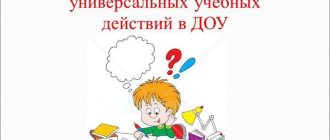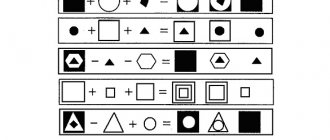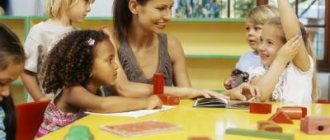Do-it-yourself didactic game guide “Entertaining cube” for preschoolers
Multifunctional game guide for preschoolers
Topic: games for preschool children Title of the work: didactic game guide “Entertaining cube” Author: Tatyana Viktorovna Morozova, teacher Place of work: MBDOU “Kindergarten No. 94” of compensating type, Dzerzhinsk, Nizhny Novgorod region Target audience: this The game manual is intended for children of senior preschool age. The goals and objectives of the manual are: development of attention, memory, thinking, formation of spatial concepts, ability to navigate on a plane, consolidate counting and knowledge of numbers within 6, development of phonemic perception, ability to differentiate and correctly pronounce sounds, expand children's knowledge horizons (knowledge about the planets of the solar system, traffic rules), fostering friendliness and the ability to negotiate. All children love to play. For a preschool child, play is the leading activity in which his psychological development takes place and his personality as a whole is formed.
In the group I work in, we made an “Entertaining Cube” for children to play with. Parents, children, and teachers took part in the work on it. Description: “Entertaining cube” is made of plywood 45x45cm, light in weight, any child can move it, bright and attractive, very compact, takes up little space. It comes with a container with a set of gaming equipment. Each face of the cube represents a playing field. The six faces correspond to six different games. The first side , intended for playing checkers and chess, does not need any special introduction.
The same can be said about the second side of the cube for playing “ Tic Tac Toe ” (for the future, we want to make the figures for the game sewn from fabric filled with small beads to increase tactile sensations and develop fine motor skills.
The third facet is the game “Find the House” .
Purpose of the game: To form spatial concepts, the ability to navigate on a plane, to be able to indicate directions in space with a word. Strengthen counting and knowledge of numbers within 6. consolidate the ability to identify by ear the first sound in a word, correlate it with the letter designation, be able to differentiate and correctly name sounds (S, Z, Sh, Zh, Ch, C). How to play: 2 to 6 children can play. The players must roll a die with letters and, in accordance with the dropped letter, select and place figures (parents and children made animal figures from salt dough) in accordance with the letter designation (S-owl, Z-hare, Sh-bumblebee, Zh-beetle, H -turtle, T-heron). Next, players take turns rolling a number die. The dropped number indicates the house number. Then the children lead their hero along the path to the house, reciting his path. For example, at first the owl will go straight, then turn left, then straight and then right. During the game you need not to make mistakes and guide your hero correctly. The fourth facet is the game "Labyrinth" .
Goal: automation and differentiation of R L sounds in words, formation of self-control skills for one’s own speech, development of memory and attention. How to play: 1 or 2 children can play. On the playing field there are images of objects that have the sounds R and L in words with directional arrows. The players, in accordance with the chosen figure (boy Roma or girl Lana), must follow the arrows of the maze to the finish line, correctly naming the sounds in the words (Roma - R, Lana with the sounds L). The Fifth Facet - the game "Space Travel"
Purpose of the game: to consolidate knowledge about the planets of the solar system, develop memory, attention, self-control. Game progress: played by 2 or more people. To play you need a cube and a chip for each person. Chips are placed at the start. Alternately throwing the dice, the players each begin to move with their chip. The winner is the one who gets to the finish line first, observing the requirements of all the signs: red - you skip a move, a yellow arrow - follow the arrow, a golden star - an extra move. The sixth facet is the game “Visiting the Traffic Light” The purpose of the game: to consolidate knowledge about the rules of the road, develop the ability to navigate the main road signs (the ability to distinguish road signs: prohibitory, service, warning, prescriptive), develop the ability to navigate on a plane, name spatial directions, development of attention, memory. Option 1.
2-4 children can participate in the game.
Each player receives a move card to the road sign. In accordance with the arrow and the number indicating the number of cells, the player must reach the given sign and tell about his path. Option 2.
The game involves 2 or more players. To play you need a cube and chips. The chips are placed at the start. Alternately throwing the dice, participants move from start to finish, observing the rules of road signs: skip a turn at a prohibiting sign; make 2 moves on the service sign; if you hit a warning sign, move to the next cell; If you hit a prescriptive sign, go back 1 square.
We recommend watching:
Quest - a game for the senior group of kindergarten “Tasks of the Wise Owl”
Similar articles:
Games to develop attention in children 3-4 years old
Games with blocks for children from 1 year to 5 years
There are, of course, also plastic, rubber and textile crumb cubes, with different jingles, puzzles and mirrors. Rubber blocks are suitable for playing in the bathroom and in the sandbox, and fabric cubes can be offered to babies up to one year old, since they weigh nothing and do not have sharp corners that a child could accidentally hit. But for a full-fledged game with cubes, we still recommend choosing simple wooden sets in which the cubes are not overloaded with unnecessary details. They are stable, which means they are ideal for building anything in the world. When interacting with wooden cubes, the baby develops correct knowledge about the weight of the object, and tactile impressions become richer. Playing with blocks develops fine motor skills. Any construction gives impetus to the development of spatial and figurative thinking, and the dexterity necessary for the game (so that the cubes stand on top of each other evenly and do not fall) automatically forms the ability to act purposefully and independently formulate game tasks.
How to play with cubes?
1. A simple set of 4-6 cubes is suitable for a child from about 9-12 months. First play hide and seek by throwing the cubes into an opaque bag or pouch. Shake the bag. Do you hear how pleasantly the wooden cubes click against each other? Hearing this sound will make your baby curious. Let him study the toy thoroughly, turn the cubes in his hands, and leave them on the floor if desired.
2. After getting acquainted with a new toy, from about 1 year old, you can show your baby how to build a simple tower from 4-6 cubes. Gradually, the level of fine motor skills will allow the child to do this more carefully and get extraordinary pleasure at the very end, when with one movement, with a roar, you can again fall apart the tower.
3. Having mastered the construction of a tower, you can take another set of cubes and compare the towers by height. This one is the lowest, this one is the middle one, and this tower is the tallest. Compare the “height” of your favorite toys and the height of the turret. The bunny is taller than the tower, and the tumbler, for example, is the same height.
4. Closer to 2 years, you can build houses with windows. Place two cubes at such a distance from each other that you can place a third cube on top without it falling. If the child succeeds, build large houses with windows of different heights and “place” his favorite toys there. Let them look out of the windows and wave their paws, welcoming the baby.
5. Lay out a small path of cubes and try to roll the ball along it as far as possible. As your child gets better at it, you can lengthen the path.
6. You can use cubes to build a wall behind which small toys could hide. The piglets are from a gray wolf. Kolobok - from a fox.
7. From about 3 years old, you can add a role-playing element to the game with cubes. Let the cubes become substitute objects. You can play as if the blocks are cars, boats, doll furniture, fruits and vegetables, a piece of birthday cake, whatever. It all depends on the plot of the game and imagination. The main thing is to show the child that any toy can quickly change its purpose if he wishes.
8. At the same age, you can organize a competition to throw cubes into a bucket. Make sure that there is nothing beating or living in the area, and go ahead and train your accuracy.
9. At 3-4 years old, with a set of cubes, you can learn colors by sorting them into different piles or matching toys of the corresponding color to each cube. Let the red car drive into the red garage, and let the frog live in the green house.
10. Children from 4-5 years old are already ready to build real castles and cities from cubes. They enjoy hands-on exploration of the laws of balance and gravity. Don't scold them if the whole room is littered with cubes. Let the built zoo or auto repair shop stand on the floor until the morning, and tomorrow it will be overgrown with new extensions and parts. At the same age, you can purchase cubes with letters and numbers to learn to add words and master counting.
DIY educational cube
The result is a cube with a hole on one side, which is useful for filling the cube with filler.
- We fill the cubes with filler: future yellow cubes - with coins, gray ones - with scraps of cardboard, blue ones - with bottle caps (this is necessary for the child to recognize sounds).
- We cover the resulting cubes with self-adhesive film.
- We apply letters to the sides of the finished cubes using a stencil, or we glue pre-cut letters.
That's all, our master class, in which we showed how to make Zaitsev's cubes with our own hands, is over. Also in the world of needlework, there are many schemes for how to make a cube from paper, as well as soft transforming cubes used in early childhood development methods such authors as Chaplygin and Nikitin. With the help of Chaplygin's educational cubes, your children will quickly learn to read and write correctly.
For this
"Logocube". Non-traditional speech therapy guide for speech development
Game “Gymnastics for the tongue” Goal: development of articulatory motor skills. Description. The pictures that are inserted into the pockets show signal drawings for articulation exercises: painter, horse, mushroom, cup, horse, etc.
d. Small poems are selected for each exercise.
The speech therapist reads a poem, the child finds this exercise and performs it. Game “Find the Picture” Purpose: differentiation of sounds in words. Description: the speech therapist lays out pictures whose names contain sounds that are close articulatory and acoustically (the same number of pictures are selected for each sound) with the pattern facing up.
Then he instructs a child or a subgroup of children to find pictures with only one sound and attach one picture to each face of the speech cube.
When all the pockets of the logocube are filled, the children check the pictures to make sure there is no conflicting sound. This game can be played to differentiate hard-soft, voiced-dull sounds.
DIY educational cube.
Flowers, ladybug, bunnies, mice, buttons, fasteners - all this can be here.
The main requirement is safety when playing.
A large educational cube will help your child learn to walk on his feet:
See how to make one.
The simplest option is to take fabric, cut it into squares and sew it according to this pattern: For stuffing, you can use foam rubber, holofiber or cereals (rice, beans, peas):
And when sewing the next developmental
Do-it-yourself educational cube “Faspers”
The doors are a gift box with a cake (cake inside), which is tied with a ribbon. The themes of the sides can be absolutely anything that comes to your mind





